
Nearly all FLC tumors carry the fusion gene DNAJB1-PRKACA and the expressed protein chimera DNAJ-PKAc which is believed to be the driver of FLC formation. However, to identify potential new therapies for FLC, it is important to understand the specific mechanisms that drive the progression of the disease. In a previous study, the Sethupathy lab identified microRNAs that were down-regulated in FLC. MicroRNAs are molecules that help cells control the types and quantities of proteins they make (by binding with messenger RNA and blocking its translation or prompting its degradation). MicroRNAs therefore control gene expression, determining whether a particular gene is making too much, too little or the normal amount of its protein at any time. Because of this role, microRNAs have been implicated as drivers of many cancers.
This study performed small RNA sequencing analysis on a large set of FLC and non-malignant samples to identify microRNAs that were upregulated in both primary and metastatic tumors. It focused on miR-10b, a dramatically up-regulated microRNA in FLC that showed the greatest increase in transcription activity relative to healthy liver tissue and whose upregulation was related to DNAJ-PKAc activity. MiR-10b has previously been shown to contribute to the progression of other types of cancer by promoting metastasis. The study’s functional analysis of miR-10b in FLC cell lines showed that the suppression of miR-10b in FLC cells leads to a modest but significant reduction in cell metabolism, growth, and proliferation.
Implications: Since the impact on growth and proliferation was modest, miR-10b inhibition by itself is unlikely to be a promising therapeutic approach for FLC. However, the results may imply a role for a miR-10b inhibitor as part of a future therapeutic combination, so miR-10b activity in FLC is worth further study.
The full text of the article can be read accessed here.
Note: This research was partially funded by a grant from FCF.
